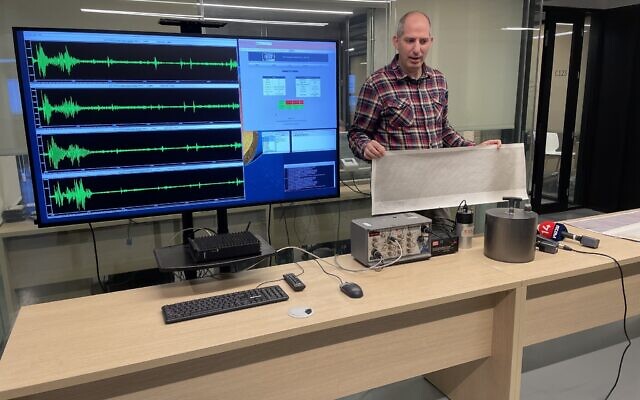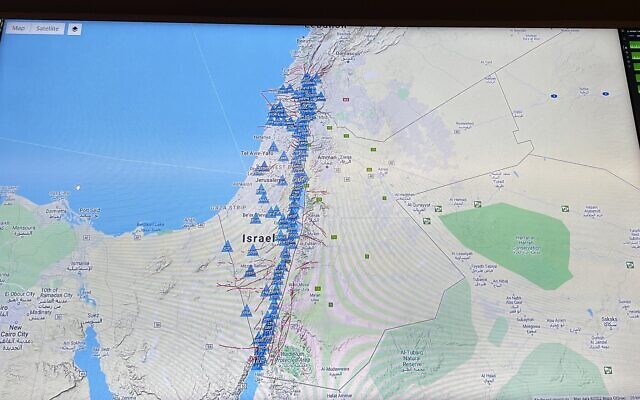Earthquake experts at the Geological Survey of Israel on Monday unveiled cutting-edge technology capable of sensing the first sign of an earthquake and having the Home Front Command send out an alert within ten seconds.
Called TRUAA, and based on a system developed at Berkley University in California, which went live in 2019, the new NIS 45 million ($14 million) national earthquake early warning system puts Israel on a par with a small number of other nations such as the US, Taiwan, and Japan.
Israel is located on the seismically active Syrian-African Rift Valley and being so small, most of its residents are exposed to the risk of earthquake damage.
Historically, the country has experienced severe earthquakes once a century, on average. The last one occurred in 1927.
Earthquake drills took place on Monday in various locations after several earthquakes were felt in Israel over the past month.
Prof Zohar Gvirtzman, director of the Geological Survey, told a press briefing that currrent technology cannot yet predict either the location, timing, or strength of an earthquake.
A screen in the situation room of the Israel Geological Survey in Jerusalem shows the epicenter of an earthquake and the movement of its initial and secondary waves, February 7, 2022. (Sue Surkes/Times of Israel)
But, by picking up the initial, weaker, tremor that precedes a stronger one, it can get the information out quickly in the hope that as many Israelis as possible within range will have enough time to seek protection.
Operating under trial conditions since 2014, TRUAA was formally connected to the Home Front Command — which is also responsible to alerting the public to incoming rocket and missile attacks — on January 27.
But, warned Gvirtzman, it would only continue to function effectively if the government committed to providing around NIS 14 million ($4.4 million) per year into the future for maintenance, research and development, and continual upgrades. This, he said, was peanuts compared to the billions of shekels invested in earthquake preparedness.

Seismologist Dr Nadav Wetzler holds a seismograph from a system no longer in use. The round object in front of him is one of the new seismometers used to detect earthquakes, Israel Geological Survey, Jerusalem, February 7, 2022. (Sue Surkes/Times of Israel)
TRUAA comprises 120 sensors called seismometers, that are buried in the ground at roughly ten kilometers (six-mile) intervals, mainly along the seismic fault lines of the Dead Sea and the Carmel Fault near Haifa in the north.
These have replaced 20 earthquake monitoring stations which were finally decommissioned in 2020.
According to Dr. Ittai Kurzon, a researcher in the geological hazards division, the sensors, which work around the clock, send digital information for automatic processing (and later, analysis by scientists) to two control centers, located in Jerusalem and Lod, 46 km (29 miles) to the northwest.
If a tremor of more than 4.5 on the Richter scale is identified, the information goes directly to the Home Front Command, which is responsible for alerting the public to danger via sirens, text messages, and radio and TV announcements. If it tops 6 on the Richter scale, the warning will be nationwide.
It takes five to eight seconds to pick up the tremor, Kurzon went on, and an additional two seconds for the alert to go out.
However, he cautioned, that is not likely to be enough time for those living near the epicenter of the quake.
The more destructive second quake moves at around three kilometers (1.9 miles) per second so that those living within a 30km (20 miles) radius would be unlikely to have time to prepare. People living 50km (30 miles) away from the epicenter of the quake would have seven to ten seconds to prepare, while those living 100 km (60 miles) away, would have up to 30 seconds.

A map of earthquake detection seismometers on a screen in the earthquake situation room of the Israel Geological Survey in Jerusalem, February 7, 2022. (Sue Surkes/Times of Israel)
Prof. Gvitzman explained that an initial quake at the northern Dead Sea in southern Israel would give Jerusalemites just three seconds to prepare until the more destructive tremblor hit, while residents of Tel Aviv would get 18 seconds, those in Beit She’an in the Jordan Valley would have around 20 seconds and Haifa residents would get some 30 seconds.
An earthquake in the Beit She’an Valley, by contrast, would not leave locals with any time to seek protection but would give Jerusalem residents 20 seconds, Tel Avivians 19, and those in Haifa around 12 seconds.
The earthquake siren is distinguishable from that for an incoming missile in that it repeats the Hebrew words for earthquake — “Reidat Adama.”
Prof Gvirtzman noted that there is, however, room for confusion. In the case of an incoming missile, the instruction was to run to a reinforced room or bomb shelter and close the door. In the event of an earthquake, the recommendation was to leave the building if possible, or, if not, run to a secure room but leave the door open.

Dr. Hila Navon, responsible for the seismology department at the Geological Survey in Jerusalem, stands in front of screens in the earthquake situation room, February 7, 2022. (Sue Surkes/Times of Israel)
While Prof. Gvirtzman emphasized that no early warning system could replace the need to strengthen buildings against earthquakes, seismologist Dr. Ran Nof said it was worth little unless the public was taught, and regularly trained, how to behave in the event of an earthquake.